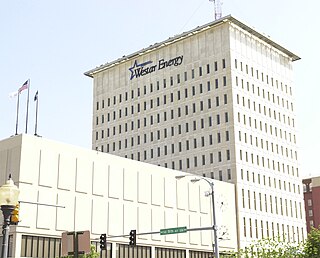Kansas City Power & Light may refer to:
- Kansas City Power and Light Company, an electric provider.
- The Kansas City Power & Light District, a downtown redevelopment area.
- The Kansas City Power and Light Building, a skyscraper.

Kansas City Power and Light Company is an electric utility company serving the Kansas City metropolitan area. It is a wholly owned subsidiary of Great Plains Energy Incorporated of which it is the biggest component. The company traces its roots to November 1881 when Joseph S. Chick obtained the exclusive rights to use the Thompson-Houston arc lighting system in the counties of Jackson, Missouri, and Wyandotte, Kansas, for $4,000. The following month, the initial franchise to establish an electric works in the City of Kansas, Mo., was granted to Lysander R. Moore and later assigned to Kawsmouth Electric Light Company. Construction was begun in February 1882 on a power plant on a tract of land at the southeast corner of 8th and Santa Fe Streets in the West Bottoms. Kawsmouth Electric Light Company built quickly and, on Saturday night, May 13, 1882, brought electric illumination to the first 13 customers on the west side of Main Street in the downtown district. In 1885 the company reincorporated as Kansas City Electric Light Company.

The Kansas City Power & Light District or Power & Light District or P&L is a dining, shopping, office and entertainment district in Downtown Kansas City, Missouri, United States, developed by The Cordish Companies of Baltimore, Maryland, and designed by Beyer Blinder Belle and 360 Architecture. The district comprises nine blocks on the south side of the downtown loop. It is located between Baltimore Avenue to the west, Grand Boulevard to the east, 12th Street to the north, and Interstate 670 to the south. The $850 million mixed use district is one of the largest development projects in the Midwestern United States, and is anchored by the renovated Midland Theatre, Alamo Drafthouse Mainstreet Cinema and the world headquarters of H&R Block.

The Kansas City Power and Light Building is a landmark skyscraper located in Downtown Kansas City, Missouri. It was constructed by Kansas City Power and Light in 1931 as a way to promote new jobs in Downtown Kansas City. Since then, the Art Deco building has been a prominent part of Kansas City's skyline. The structure was the tallest building west of the Mississippi River upon its completion after succeeding the Smith Tower until the completion of the Space Needle in 1962. The east façade of the building faces the Power & Light District, and the building's iconic lantern appears on promotional materials and signage for the district and even Kansas City as a whole.
| This disambiguation page lists articles associated with the title Kansas City Power & Light. If an internal link led you here, you may wish to change the link to point directly to the intended article. |







